9 Hot Spring Facilities in Tokyo and Nearby Onsen Destinations

Onsen, or hot springs, are the quintessential Japanese experience and a great way to relax during your trip. In this article we introduce the best hot springs in Tokyo and in nearby suburban areas for visitors coming to Japan's capital.
Visit Onsen in Tokyo - Relaxing Hot Springs
An essential part of any trip to Japan is relaxing at an onsen, or hot spring. When it comes to onsen, well-known hot spring areas such as Hakone and Beppu soon come to mind, but you can also enjoy onsen in Tokyo as well.
Also, if you you go to Hakone, Nikko, or any of the other onsen areas, you can enjoy delicious cuisine and relax in hot springs in a Japanese-like environment, and even stay at a hot spring ryokan.
Out of all the hot springs and bathing facilities in Tokyo, we have picked our top ten spots for visitors coming to Japan.
If you're going to use a hot spring within the city limits, we recommend the sento (public bath) which are frequented by locals, and the super sento (sometimes called kenko land, a relaxation spa), which are larger sento combined with entertainment services and other facilities.
At a sento, you can use a Japanese-style bath or hot spring. At a super sento, in addition to the bath you can enjoy a host of other services as well, including massage chairs, eating establishments, and amusement facilities.
9 Hot Spring Facilities in and near Tokyo
1. Tokyo Dome Spa LaQua in Suidobashi
2. Toshimaen Niwa-No-Yu in Nerima
3. Musashi Koyama Onsen Shimizuyu in Musashi Koyama
4. Mikokuyu in Ryogoku and Kinshicho
5. Maenohara Onsen Saya-No-Yudokoro in Shimura Sakue
6. Hidamari-No-Izumi Haginoyu in Uguisudani
Onsen Areas for Day Trips from Tokyo
7. Hakone, Yugawara, and Atami
8. Nikko, Kinugawa, and Yunishigawa
9. Kusatsu Onsen
1. Tokyo Dome Spa LaQua in Suidobashi

Picture courtesy of Tokyo Dome Corporation
Spa LaQua is located inside Tokyo Dome City, Tokyo's largest entertainment area.
In addition to Spa LaQua, there's a large shopping complex, an amusement park, and a hotel all in one, so this facility can be a great place to stay when traveling, as well as a great sightseeing spot.
Tokyo Dome is holds sports games, concerts and a wide range of events. Why not dropping by on your way home from one of these events ease your tiredness at Spa LaQua?
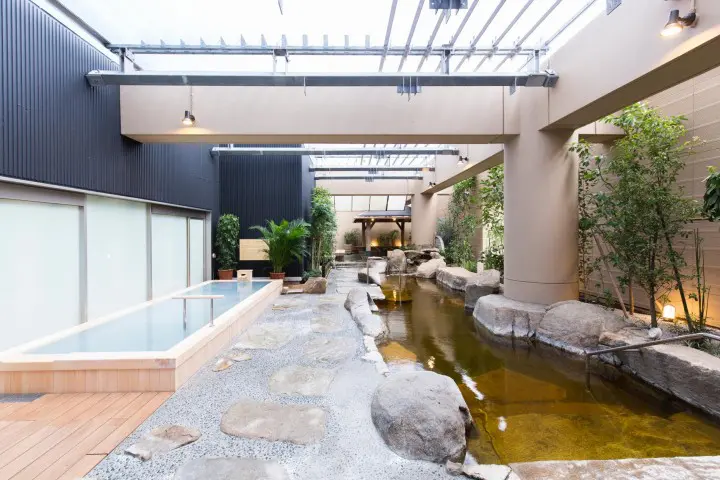
Picture courtesy of Tokyo Dome Corporation
At Spa LaQua, there's rotemburo filled with natural spring water gushing out from 1,700 meters underground, a low-temperature sauna and other hot spring amenities, in addition to body care and chiropractic area, and a hair treatment service.
Prices:
Adults (18 years and up) - 2,900 yen with tax
6 to 17 years of age - 2,090 yen with tax (must be accompanied by an adult)
*children 5 years old and under aren't allowed to enter
Access:
1 minute on foot from Korakuen Station (Tokyo Metro Marunouchi Line, Nanboku Line), 2 minutes on foot from Kasuga Station (Toei Oedo Line), 3 minutes on foot from Suidobashi Station (Toei Mita Line), 6 minutes on foot from Suidobashi Station (JR Line).
Location:
Tokyo, Bunkyo, Kasuga 1-1-1 (Tokyo Dome City LaQua 5th-9th floors, front desk is on 6th floor). Google Map
For the official homepage of Spa LaQua please click here
↑ Return to the top of article.
2. Toshimaen Niwa-No-Yu in Nerima

Picture courtesy of Toshimaen Niwa-No-Yu
For those who often visit or pass through Shinjuku and Ikebukuro, Toshimaen Niwa-No-Yu located in Nerima Ward, is conveniently accessed.
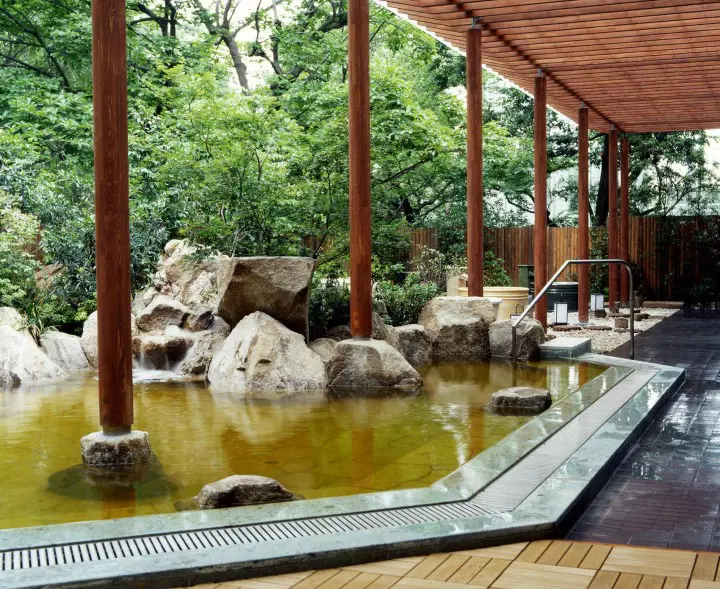
Picture courtesy of Toshimaen Niwa-No-Yu
The name Niwa-No-Yu ("niwa" meaning garden) was given to this facility because there's a large, traditional Japanese garden inside the premises.
Covering some four thousand square meters, this garden surrounds Niwa-No-Yu's building. In the spring, there are cherry blossoms, and in the autumn there's Japanese pampas grass, so one can enjoy the beauty of the plants and flowers in each season.
In addition to natural hot springs with a view of the Japanese garden, the body zone, where you can dip into the water wearing your bathing suit, is also worth checking out. For visitors who find the idea of being naked in front of other bathers uncomfortable, the body zone is an ideal way to enjoy the hot springs and baths.
Prices:
Regular (Junior high school students and up)- 2,350 yen.
Night Spa (after 18:00)- 1,320 yen *excluding New Year's holidays, the Obon season, and Golden Week.
Access:
1 minute on foot from Toshimaen Station (Seibu Ikebukuro Line), 2 minutes on foot from Toshimaen Station (Toei Oedo Line).
Location:
Tokyo, Nerima, Koyama 3-25-1 Google Map
For the official homepage of Toshimaen Niwa-No-Yu, please click here (Japanese).
↑ Return to the top of article.
3. Musashi Koyama Onsen Shimizuyu in Musashi Koyama
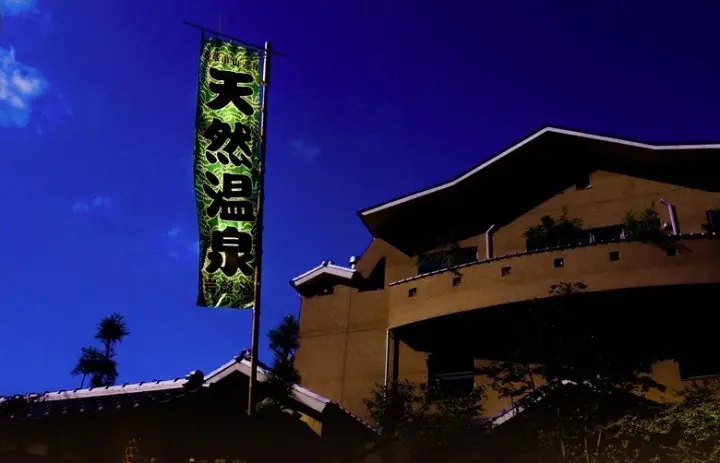
Picture courtesy of Musashi Koyama Onsen Shimizuyu
Musashi Koyama Onsen Shimizuyu, is a local sento that's been in business since 1924. This sento is located west of Tokyo's central area. It is in the ideal location for those who frequent Shinagawa and Shibuya.
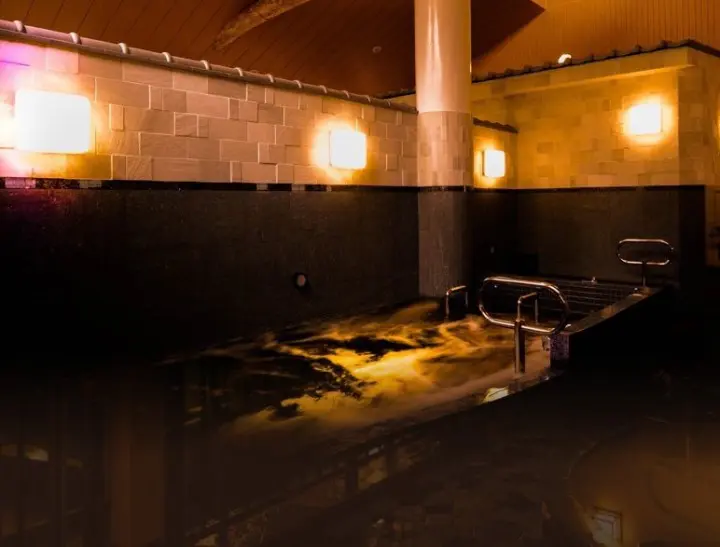
Picture courtesy of Musashi Koyama Onsen Shimizuyu
The characteristic feature at Shimizuyu is that guests can use two different hot springs at the same place. In addition to Tokyo's own kuroyu (dark-colored water filled with minerals), there's also ogon-no-yu, where the water sparkles with a golden color.
Also, unusual for a sento, there's a ganbanyoku (*3) spa facility (requires an extra charge).
Please remember that this is a very popular sento, so it can often be crowded.
*3 ganbanyoku: One kind of sauna in which one lies down on a heated rock to warm up the body. Is believed to have health benefits.
Prices:
Adults 470 yen, Junior High School students 300 yen, Children 180 yen.
Access:
5 minutes on foot from Musashi Koyama Station (Tokyo Meguro Line).
Location:
Tokyo, Shinagawa, Koyama 3-9-1 Google Map
For the official homepage of Musashi Koyama Onsen Shimizuyu please click here (Japanese).
↑ Return to the top of article.
4. Mikokuyu in Ryogoku and Kinshicho
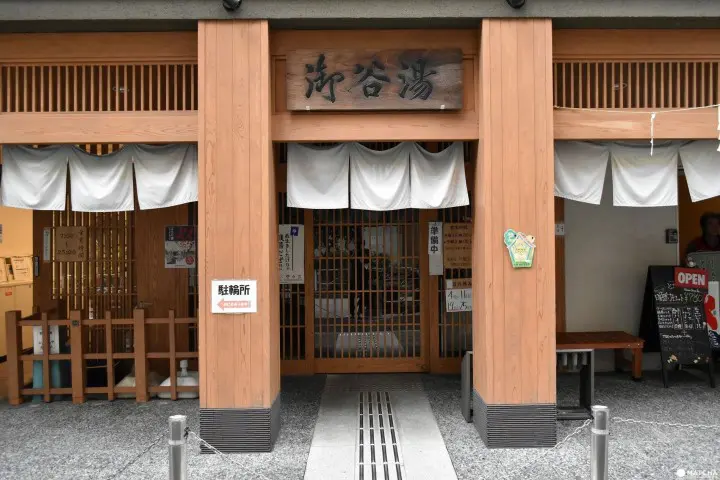
Picture from Access From Skytree And Senso-ji Temple! Three Bathhouses In Asakusa
Tokyo's Sumida Ward is an area known for the towering Tokyo Skytree. Mikokuyu, is located midway between the local areas of Ryogoku, famous for sumo; Kinshicho, known as a lively shopping district; and Oshiage, home to Tokyo Skytree.
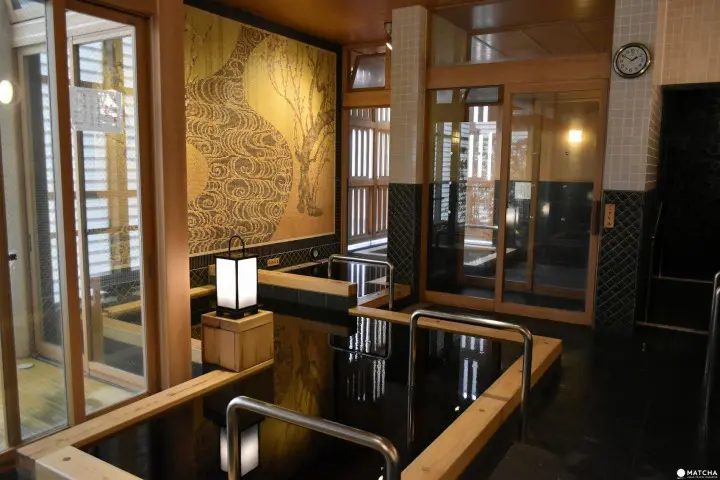
Picture from Access From Skytree And Senso-ji Temple! Three Bathhouses In Asakusa
Mikokuyu is ideally located, allowing guests to admire the view of Tokyo Skytree from their rotemburo. In 2015, it was completely remodeled and its sophisticated interior now has a modern, Japanese feel to it.
The sento has a wall mural of Mt. Fuji and also a tile pictograph based on Kohaku Baizu Byobu (*4).
*4 Kohaku Baizu Byobu: The folding screen of Red and White Plum Blossoms. An 18th century screen painting by Ogata Korin. Considered a national treasure, the original work of art is currently part of the collection at the MOA Museum of Art in Shizuoka prefecture's Atami city.
Price:
Adults- 470 yen
Access:
16 minutes on foot from Kinshicho Station (Tokyo Metro), 12 minutes on foot from Honjo-Azumabashi Station (Toei Asakusa Line).
Location:
Tokyo, Sumida, Ishiwara 3-30-8 Google Map
For the official homepage of Mikokuyu please click here (Japanese).
↑ Return to the top of article.
5. Maenohara Onsen Saya-No-Yudokoro in Shimura Sakue

Picture courtesy of Maenohara Onsen Saya-No-Yudokoro
Located in Itabashi Ward, Saya-No-Yudokoro is an onsen housed in a tasteful, Japanese-style building. There's a hot spring pool, sauna, restaurant, and Japanese garden.
During the week, guests can enjoy the facility for a modest 870 yen (1,120 yen on Saturdays, Sundays, and holidays), making this reasonable price an attractive feature of this onsen.

Picture courtesy of Maenohara Onsen Saya-No-Yudokoro
For just 2,100 yen you can reserve the rotemburo all to yourself for one hour. For those guests who feel uncomfortable without clothes in front of others, this is a great service that allows you to enjoy the pool with just family or close friends.
Right next to the onsen there's a supermarket, so after taking a dip in the pool, you can buy groceries and something to eat. Though this onsen is a little distance from the main sightseeing spots and taking a bus is required, it has many special features that make it a worthwhile place to visit.
Prices:
Weekdays- 870 yen. Saturdays, Sundays, and holidays- 1,200 yen.
Access:
8 minutes on foot from Shimura Sakaue Station (Toei Mita Line). You can also take a Kokusai Kogyo bus (Red 53) from the west exit of JR Akabane Station, then get off at Maenocho 3-chome bus stop and the onsen is right there. The bus travel time is 10 minutes and the ticket costs 220 yen.
Location:
Tokyo, Itabashi, Maenocho 3-41-1 Google Map
For the official homepage of Saya-No-Yudokoro please click here
↑ Return to the top of article.
6. Hidamari-No-Izumi Haginoyu in Uguisudani

Picture courtesy of Hidamari-No-Izumi Haginoyu
Hidamari-No-Izumi Haginoyu, located just minutes from the JR Yamanote Line's Uguisudani Station, is a sento that opened in 2016.
Though Uguisudani is a town that's not very familiar to visitors outside of Japan, it's actually very close to Asakusa and Ueno, accessible by bus, taxi, and even on foot.

Picture courtesy of Hidamari-No-Izumi Haginoyu
Just like Saya-No-Yudokoro, Hidamari-No-Izumi has an impressive lineup of services and facilities. There's a large hot spring, a sauna, a carbon dioxide bath (*5), along with a restaurant, so you can enjoy a meal after you finish using the onsen.
The price is 470 yen, similarly priced to other sento (sauna and other special areas have a separate price).
*5 tansan onsen: Also known as a carbonated hot spring. A kind of bath in which carbon dioxide has been dissolved into the water. The carbon dioxide particles adhere to the skin which is thought to have medicinal benefits. One can expect improved blood circulation and a higher body temperature.
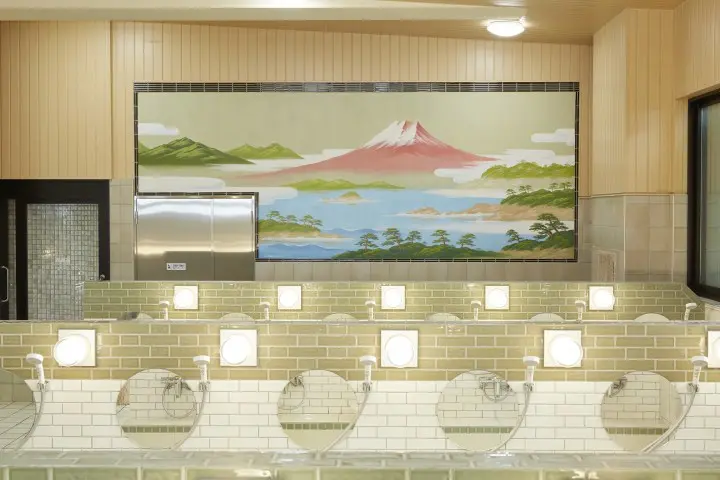
Picture courtesy of Hidamari-No-Izumi Haginoyu
A feature of this sento is its morning operation, from 6:00 to 9:00, allowing guests to use the baths in the early hours of the day. If you are staying nearby, this sento is the ideal place to take a dip in between checking out of your accommodation and leaving for the next part of your journey.
Prices:
Adults- 470 yen, Students (Elementary and Junior High)- 180 yen, Children- 80 yen.
Access:
3 minutes on foot from JR Uguisudani Station.
Location:
Tokyo, Taito, Negishi 2-13-13 Google Map
For the official homepage of Haginoyu please click here (Japanese).
↑ Return to the top of article.
Onsen Areas for Day Trips from Tokyo
Japan is dotted with countless onsen areas, where hot spring water flows to the ground surface. In these locations, visitors can come into contact with Japanese-style streetscapes, strolling through towns and learning about the history of Japanese hot springs.
Next we introduce onsen areas located in suburban neighborhoods easily accessible from Tokyo.
↑ Return to the top of article.
7. Hakone, Yugawara, and Atami

Hakone's symbol, Ashinoko Lake. Picture courtesy of the Town of Hakone
It goes without saying that Hakone is a famous sightseeing spot. It's also recognized as an onsen resort area by overseas visitors.
Around ten kilometers away is Yugawara and also Atami onsen. Though they are small scale hot spring areas compared to Hakone, unlike Hakone, they face the ocean, allowing visitors to enjoy spectacular scenery and delicious, fresh seafood.
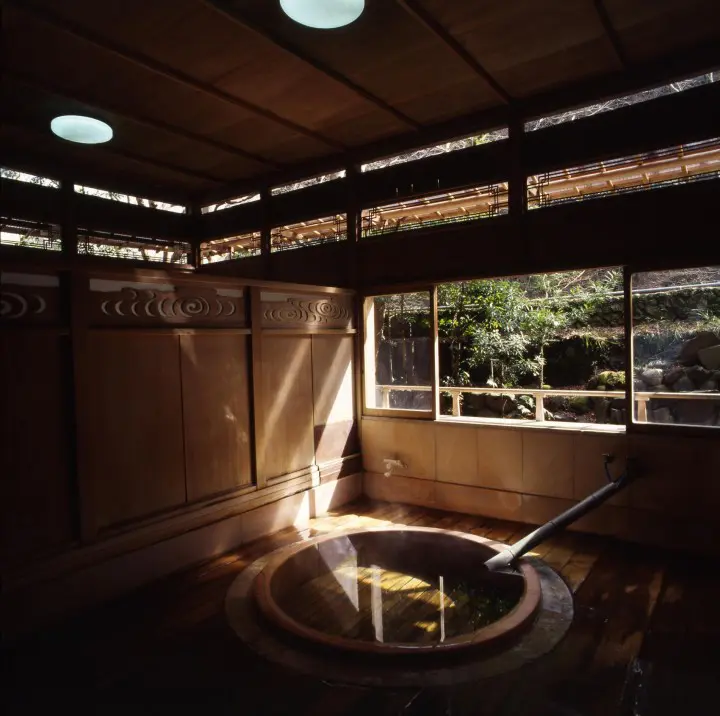
A hot spring hotel founded in 1890, Fukuzumiro. Picture courtesy of the town of Hakone
Hakone:
For Hakone's official homepage please click here (Hakone Tourist Association).
Yugawara:
For Yugawara's official homepage please click here (Yugawara Onsen Tourist Association).
Atami:
For Atami's official homepage please click here (Atami Town Tourist Association).
Read also
↑ Return to the top of article.
8. Nikko, Kinugawa, and Yunishigawa
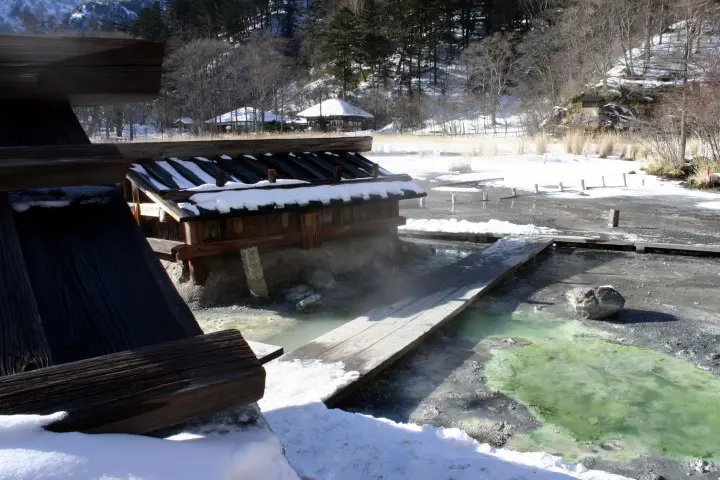
The source of Nikko Yumoto Onsen gushing out. Picture courtesy of Nikko City Tourist Association
The city of Nikko, known for its world heritage Nikko Toshogu Shrine, also happens to be a famous hot spring area.
Onsen facilities and hotels have been built near Tobu Nikko Station, Chuzenji Lake, and in other key areas, so you can choose a location that best suits your travel plan.
Nikko homepage: click here

The colorful autumn foliage in Yunishigawa Onsen town. Picture courtesy of: Nikko City Tourist Association

Kinugawa Plaza Hotel's rotemburo can be reserved. Picture courtesy of Nikko City Tourist Association
Further into Nikko you can find Kinugawa Onsen, a facility sitting by a river. Further along is Yunishigawa Onsen, known for its mystical Kamakura Festival (a festival featuring miniature kamakura, or snow huts, illuminated by candles placed inside).
Nikko
For Nikko's official homepage please click here (Nikko City Tourist Association).
Kinugawa
For Kinugawa's official homepage please click here (Nikko City Tourist Association).
Yunishigawa
For Yunishigawa's official homepage please click here (Nikko City Tourist Association).
Read also
↑ Return to the top of article.
9. Kusatsu Onsen
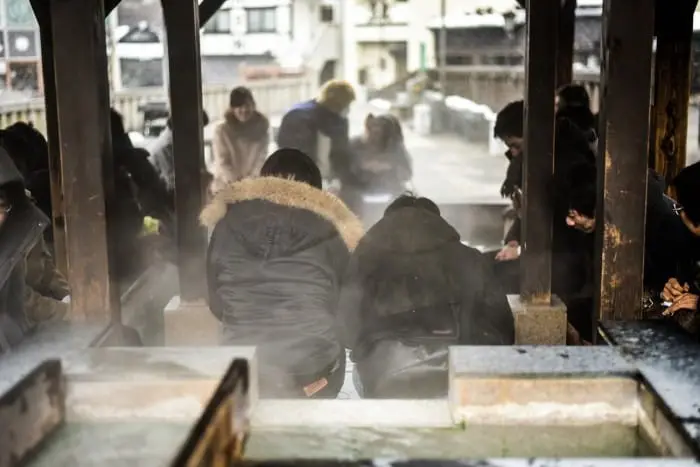
Picture from The Beauty Of Kusatsu Onsen In Winter: Snowflakes And Hot Springs
Kusatsu Onsen has a long history, and since the Edo period has been known as one of the top three hot springs in Japan, alongside spots including Hyogo Prefecture's Arima onsen, and Gifu prefecture's Gero onsen.

Picture from The Beauty Of Kusatsu Onsen In Winter: Snowflakes And Hot Springs
Today, Kusatsu Onsen is still well-visited and popular. In the middle of this spa village is yubatake (literally "hot water field"), where four thousand liters of hot spring water come gushing out every minute, showcasing Kusatsu's pure and bountiful water source.
Yumomi, the task of cooling down the hot spring water to a bathing temperature, has continued since the Edo period. Today it is done in the form of a show, and visitors watching this performance will feel moved by the rich history at Kusatsu Onsen.
For the official homepage of Kusatsu Onsen, please click here (Japanese).
*In January of 2018, Mount Kusatsu-Shirane, located near Kusatsu onsen, erupted. At the present time (June, 2018), there haven't been any further eruptions and Kusatsu onsen is back to normal operations.
↑ Return to the top of article.
Japan's Hot Summers - Can You Still Enjoy Onsen?
Yes, you can! While hot springs might mainly be something people associate with the colder month, many Japanese people love to use hot springs in summer. It is basically treated like a sauna in other countries. The sweat will flush out toxins from your body and improve blood circulation.
Don't worry, most onsen facilities have cold baths as well to cool you down in between hot baths. You could also use the shower facilities if there the cold bath is not available.
Bathing in the hot springs for healing purposes in the hot humid summer is a very unique experience. You should definitely give it a try!
↑ Return to the top of article.
FAQ
What is the closest hot spring town to Tokyo?
Hakone is one of the closest hot spring (onsen) towns to Tokyo, making it a popular destination for a relaxing getaway from the city. Located in Kanagawa Prefecture, Hakone is situated about 1.5 to 2 hours away from central Tokyo by train, making it easily accessible for a day trip or a weekend retreat.
Hakone is known for its picturesque views of Mount Fuji, serene lakes, traditional ryokan (inns), and diverse onsen experiences, including outdoor baths (rotenburo) and indoor baths with various mineral-rich waters. Visitors can enjoy soaking in the soothing hot springs while surrounded by nature, making Hakone a favorite choice for locals and tourists looking to unwind and rejuvenate in a tranquil setting close to Tokyo.
What is the most popular hot spring in Japan?
One of the most famous and popular hot spring (onsen) resorts in Japan is Beppu, located in Oita Prefecture on the island of Kyushu. Beppu is renowned for its abundant geothermal activity, offering a variety of hot springs with different mineral compositions and therapeutic properties. Known for its unique "hells" (jigoku) where visitors can view hot springs of various colors and temperatures, Beppu attracts both domestic and international visitors seeking relaxation and wellness experiences.
Beppu's hot spring districts, including Beppu Onsen, Kannawa Onsen, and Myoban Onsen, feature a wide range of bathing facilities such as steam baths, mud baths, sand baths, and foot baths. The town's versatile offerings cater to different preferences, from traditional indoor baths to open-air baths overlooking scenic landscapes. Beppu's status as a leading hot spring destination in Japan is bolstered by its rich history, diverse bathing experiences, and the therapeutic benefits of its mineral-rich waters, making it a top choice for those seeking a quintessential onsen experience in the country.
Which onsen is best for foreigners in Japan?
For foreigners seeking a comfortable and welcoming onsen experience in Japan, several hot spring resorts are well-known for their foreigner-friendly services and facilities. Gero Onsen in Gifu Prefecture stands out for its high-quality waters and English-speaking staff, providing clear signage and services tailored to international guests. Kusatsu Onsen in Gunma Prefecture offers a wealth of ryokan and public baths with multilingual information and assistance to help foreign visitors navigate the onsens and town easily. Hakone Onsen in Kanagawa, near Tokyo, combines stunning views with diverse hot spring experiences, often featuring English-speaking staff and communication for international travelers. Noboribetsu Onsen in Hokkaido offers various types of onsen waters, including sulfur springs, with accommodations and services friendly to foreigners. Beppu Onsen in Oita Prefecture, known for its diverse hot spring offerings, provides amenities and establishments with English-speaking staff and foreigner-friendly services, ensuring a comfortable and enjoyable onsen experience for international guests exploring the rich tradition of Japanese hot springs.
How much does it cost to go to the hot springs in Tokyo?
In Tokyo, the cost of visiting hot springs (onsen) can vary depending on the type of establishment and the facilities offered. Traditional public baths (sentos) in Tokyo typically charge around 400 to 800 yen per person for entry, with additional fees for towel rentals and toiletries. Onsen facilities within the city, mimicking natural hot springs, may range from 1,000 to 3,000 yen or more per person, depending on the venue and amenities provided. Onsen theme parks like Ooedo Onsen Monogatari and luxury spa resorts in and around Tokyo can start from 2,000 to 3,000 yen and 5,000 yen per person, respectively, for access to their hot spring baths and premium services. Additional costs might apply for towel rentals, treatments, or special services at the onsen, while some facilities may offer discounts or promotions based on specific circumstances or timings.
What is the difference between onsen and hot spring?
The distinction between "onsen" and "hot spring" lies in their specificity and scope. While both terms refer to geothermal water sources with elevated temperatures, "onsen" is a culturally significant Japanese term denoting hot springs that meet specific criteria set by Japanese regulations. These criteria include requirements related to mineral composition, temperature thresholds, and cleanliness standards, with onsen typically associated with traditional bathing practices and relaxation in Japan. Onsen are a part of Japanese culture and are often found in natural outdoor settings or purpose-built facilities, emphasizing a connection to wellness and therapeutic properties. In contrast, "hot spring" is a more general term used worldwide to describe natural geothermal water sources, with variations in regulations, standards, and cultural practices depending on the location and country. While all onsen are hot springs, not all hot springs are classified as onsen in the context of Japanese geothermal bathing culture and tradition.
What are the three famous hot springs in Japan?
Three of Japan's most renowned hot springs include Beppu Onsen in Oita Prefecture, famous for its geothermal diversity and vibrant "hells"; Kusatsu Onsen in Gunma Prefecture, celebrated for its therapeutic sulfuric waters at the symbolically rich Yubatake; and Dogo Onsen in Ehime Prefecture, an ancient onsen town steeped in a thousand-year history and known for its iconic traditional bathhouse, Dogo Onsen Honkan. Beppu offers a wide array of baths like mud, sand, and steam, while Kusatsu's mineral-rich waters are esteemed for their health benefits. Dogo Onsen's cultural significance shines through its historic wooden bathhouse, a symbol of timeless Japanese bathing customs and a notable inspiration in popular culture. Each onsen destination captures a unique blend of history, healing properties, and architectural charm, attracting visitors seeking to delve into Japan's revered onsen culture and experience the therapeutic and cultural wonders of these famous hot spring towns.
↑ Return to the top of article.
Relieve Your Travel Fatigue in a Tokyo Hot Spring!
Japanese onsen have long been used as places for improving health and relaxing.
Tiredness builds up easily when you are traveling internationally. Please experience Japan's unique bathing culture at a hot spring or sento to feel refreshed and ready to continue your trip.
Book the Tokyo Subway Pass to Explore Tokyo Conveniently!
Read also
Download the MATCHA app for Japan travel: Apple Store | Google Play Store
MATCHAで編集やってます植松です。87世代。


















































![[2026] Top 5 Strawberry Picking Spots in Tokushima, Naruto| Farms and Access Guide for January to May](https://resources.matcha-jp.com/resize/720x2000/2025/03/06-227165.webp)



